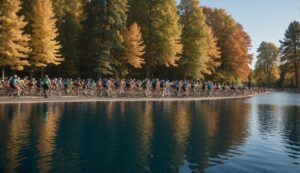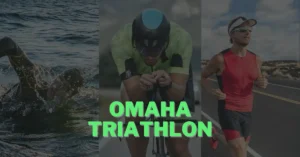📦 FREE Shipping
How Long Does a Triathlon Take: Race Duration Insights 2024!

Engaging in a triathlon is one of the most vivid accomplishments an endurance athlete can attain. You might have wondered: How long does a triathlon take? It’s an event that tests your limits across swimming, cycling, and running, all in a single bout of extensive physical effort.
The fervor around these races continues to surge with more people—from novices to seasoned professionals—eager to push their boundaries and add the title of ‘triathlete’ to their repertoire.

The duration of a triathlon can vary significantly depending on the distance of the event. I’ve encountered super sprint triathlons, which are notably the shortest, manageable to finish in as little as an hour for many. On the spectrum’s other end lies the Ironman, a behemoth that only the most tenacious endurance athletes can complete, typically necessitating anywhere from 8 to 17 hours depending on a multitude of factors including training, conditions, and experience.
Chasing that finish line under my own steam was an extraordinary feeling. I’ve trained my heart out and felt a sense of triumph unparalleled by any other sporting event. The popularity of the sport isn’t unwarranted; it’s the ultimate testament to an individual’s dedication, resilience, and the sheer will to succeed. Whether in the water, on the saddle, or pounding the pavement, every triathlon I join brings a renewed sense of excitement and achievement.
Understanding Triathlon Distances
Triathlons come in a variety of distances to cater to different skill levels and endurance capacities, each with its own standard for swim, bike, and run segments.
Sprint and Super Sprint Triathlon
Sprint Triathlon typically consists of a 750-meter (0.47 miles) swim, a 20-kilometer (12.4 miles) bike ride, and a 5-kilometer (3.1 miles) run. Athletes can expect to complete this brisk challenge in about 1-2 hours, depending on their pace. For newcomers looking for something even shorter, the Super Sprint Triathlon is ideal, often featuring a 400-meter swim, 10-kilometer bike, and 2.5-kilometer run, an accessible format that can take under 1 hour to finish.
Olympic and Standard Distance Triathlon
An Olympic Triathlon, also known as the Standard Distance, ups the ante with a 1.5-kilometer (0.93 miles) swim, 40-kilometer (24.8 miles) bike, and 10-kilometer (6.2 miles) run. For those ready to challenge their endurance, completing this race typically takes around 2 to 3 hours.
Half Ironman / 70.3 Triathlon
The intense Half Ironman, or Ironman 70.3, involves a 1.9-kilometer (1.2 miles) swim, 90-kilometer (55.9 miles) bike, and 21.1-kilometer (13.1 miles) run. It’s a race that demands higher endurance, with finish times usually ranging from 4 to 6 hours.
Full Ironman Triathlon
At the peak of triathlon distances is the grueling Full Ironman Triathlon. Participants swim 3.8 kilometers (2.4 miles), cycle for 180.2 kilometers (112 miles), and run a full marathon 42.2 kilometers (26.2 miles). The pros may cross the finish line in 8 to 10 hours, but for many, completing this monumental task is an all-day event.

Training for Success
Embarking on a triathlon journey, I’ve discovered that success is anchored in a well-structured training plan, balance across all three disciplines, mindful nutrition and recovery, and mastering the art of transitions.
Developing a Training Plan
My triathlon training is methodical. I ensure my training plan is detailed, gradually building endurance and incorporating various intensities. For long-distance events, I dedicate at least 16 weeks of preparation, carefully increasing my training load to peak at the right moment.
Balancing Swim, Bike, and Run
I distribute my training time wisely: about 20% swimming, 50% cycling, and 30% running, which reflects the proportion of each discipline in race conditions. Each week, I mix in different workouts focused on speed, technique, and strength to excel in swimming, cycling, and running.
- Swimming: 2-3 times a week with a focus on technique and endurance. Wetsuits improve buoyancy and speed.
- Cycling: 3-4 times, balancing between long rides and interval training to build leg strength and pacing skills.
- Running: 3 times, including long runs and anaerobic sessions for speed and efficiency.
Importance of Nutrition and Recovery
My fuel and recovery strategy is crucial. I prioritize a balanced diet rich in carbohydrates, proteins, and fats to fuel my training sessions. Post-workout, I focus on hydration and quality protein intake to repair muscles. Sleep and active recovery days are scheduled to prevent overtraining.

Transition Between Disciplines
The fourth discipline in triathlon is transitioning. I practice transitions to shave off valuable seconds on race day, rehearsing the switch from swim to bike and bike to run. This includes quick changes in gear, from wetsuit removal to mounting my bike efficiently.
Race Day Execution
In triathlons, my focus on race day execution is crucial for a stellar performance, as I navigate transitions, pacing, and endure the physical and mental demands.
Mastering Transitions
I’ve learned that transitions are more than just a break between race segments; they’re critical phases where every second counts. In triathlons, the transition from swim to bike (T1) and bike to run (T2) can greatly affect my total race time. I meticulously organize my gear to ensure efficiency. For T1, I have my helmet facing up with straps out, sunglasses inside, and biking shoes open. T2 requires my running shoes with elastic laces for quick slip-on, saving precious seconds.
Pacing Strategies
Pacing is not just about being fast; it’s about being smart. During triathlons, I develop a pacing strategy for each section: swim, bike, and run distances. My objective is to maintain even splits throughout the race distances, conserving energy early to prevent a fade late in the race. For instance, if the bike distance is 180 kilometers, I aim to sustain a strong, yet steady pace, taking into account elevation and headwinds. I use my race experience and training data to dictate my effort levels, which helps me avoid hitting the metaphorical ‘wall’.
Mental and Physical Endurance
The mental game is as significant as the physical one. I ensure my endurance is up to par for the grueling swim, bike, and run distances. I use positive self-talk and break the race into manageable segments, focusing on one at a time. To boost my physical stamina, I include race-pace intervals in my training. For example, near the end of a long run, I include a few minutes at my goal race pace to simulate tired legs. This preparation gives me the confidence to push through when fatigue sets in.
Fostering the Triathlon Community
In my experience, the triathlon community thrives on participation, inclusivity, and the shared excitement of pushing personal limits. It’s a space where professional and beginner triathletes alike come together to celebrate their love for the sport.
Local and Global Events
I’ve seen firsthand how local triathlons serve as gateways for beginners. These events, which can range from a sprint triathlon to an Olympic triathlon, provide a supportive atmosphere that encourages new athletes to join. On the global stage, events like the ITU World Triathlon Championship Series and the Ironman World Championship are not only spectacles for pro triathletes but also bring together participants from around the world, elevating the prestige of the sport and fostering a sense of unity among competitors of all levels.
Triathlon for All Ages and Levels
Whether you’re a youngster eager to dive into a multisport event or an older athlete aiming for an age group title, there’s a place for you in triathlon. Relay triathlons are great for families and groups with mixed skill levels. The Outside+ app offers training guidelines and tips that cater to everyone, making the journey toward an Ironman triathlon or any other format feasible and enjoyable. The sense of accomplishment crossing the finish line is a universally shared feeling, no matter the age or skill level.
The Role of Professional Athletes
I admire how pro triathletes carry the torch of inspiration for the community. Their quests for breaking a world record or taking home gold at the Olympic Games are more than just personal achievements; they act as beacons that draw increased popularity to the sport. Professional athletes often offer coaching and support to novice triathletes, reinforcing the sport’s inclusive nature and inspiring the next generation to reach new heights.
Frequently Asked Questions about how long does a triathlon take
Triathlons are the ultimate test of endurance and each race is a thrilling journey! I always get a buzz from discovering how far I can push my limits in these competitions, and I know many of you have burning questions about the time it takes to complete one. Let’s dive right in!
What’s the average finish time for a beginner in a triathlon?
For beginners like me, a triathlon can take anywhere from 1 to 3 hours. It’s such an exhilarating rush to cross that finish line!
What exhilarating achievements are to be expected for sprint triathlon times by age group?
Sprint triathlon times for different age groups are exciting! Younger athletes may complete in under an hour, while older competitors like me may aim for 1-2 hours.
Can you believe the ideal Olympic triathlon completion times?
The ideal finish time for an Olympic triathlon is around 2 hours for pros and 3 hours for amateurs like me. I find striving for this time electrifying!
How thrilling is it to track triathlon progress across different age categories?
Tracking my triathlon progress is thrilling, especially when I see improvements across races. It’s captivating to compare times as I move through different age categories.
What’s the buzz about the amount of training required before rocking a triathlon?
I’ve found preparing for a triathlon takes consistency and dedication. On average, 5-10 hours per week of training gets me ready to rock the race.
Aren’t you curious about the expected duration of the various triathlon distances?
I’m always curious! Triathlons range from super sprints (under an hour) to full Ironmans (up to 17 hours). Each distance offers a unique challenge that I’m eager to tackle.
Is your question “How long does a Triathlon take?” answered? Leave me a comment and make sure to also check out Triathlon Equipment and What is an Ironman Run.





